A damp proof course (DPC) is a physical barrier inserted into the fabric of a building to stop water passing from one place to another. This can be on a horizontal plane, stopping water rising up from the ground by being sucked up by the dry masonry above, or vertically to stop water passing from the outside of a building, though the masonry, to the inside.
DPC’s have taken many forms through the ages and one of the earliest forms was to use a layer of slate in the construction. Slate is still used but the less expensive plastic version is now more widely used.
In some instances a DPC can fail and cause water and moisture to creep up through a wall, causing untold damp issues. In this guide you will find out about damp proof injection and how to install a damp proof course yourself.
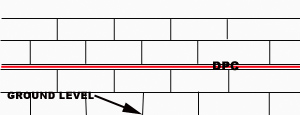
Damp Proof Course indicating DPC and ground level
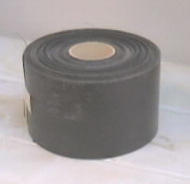
Damp Proof Course
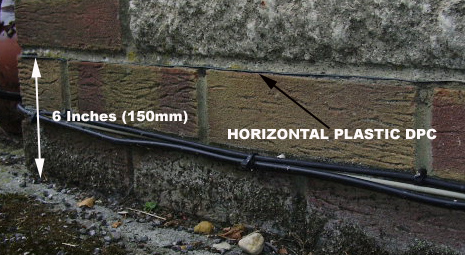
Damp Proof Course indicating 6 inches from damp proof course to ground level
A horizontal damp proof course is usually placed 6 inches above ground level and used in conjunction with a damp proof membrane which stops water rising to any part of the ground floor from the ground.
A diagram of a typical ground floor construction can be seen below and you can see how a Damp Proof Course works in conjunction with the membrane to stop any water rising up into the building above.
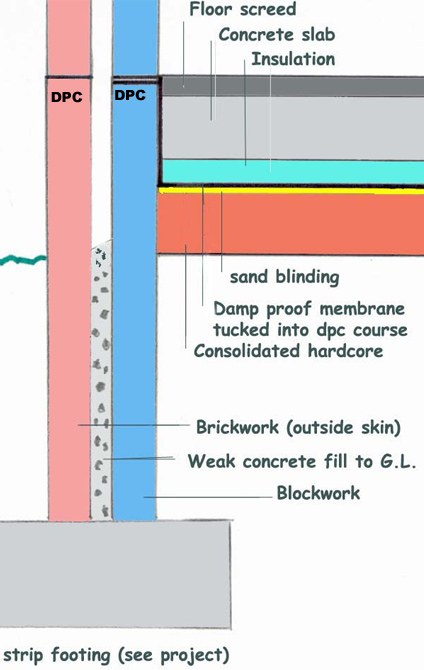
Damp Proof Course Cross Section indicating ground floor slab and inner and outer cavity wall DPC’s
In many older properties a non porous stone was used to build the first few courses of masonry but over the years this stone in many instances has become porous allowing water to be soaked up through it.
It is not practical in most cases to remove a course of stone to place a plastic, lead or slate DPC in the wall and new methods have been found of introducing a DPC (damp proof course) where there is either none, or one that is broken in some way.
These methods generally require the injection of chemicals into the walls and, on a larger scale, are better done by specialists as there are many complications which can arise as a result of saturated plaster and the measurement of the chemical being injected.
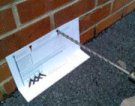
DPC Injection made easy with modern techniques and drilling templates – Image courtesy of Property Repair Systems
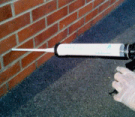
Modern DPC Injection Cream – no special tools, no smell and can be installed by anyone
Now you can make repairs or add a DPC to small projects using a unique DIY method involving simple injection of a specialised cream using a normal sealant applicator gun after drilling 12mm holes to inject into!
DIY Damp Proofing – An Easy Solution for Damp Proof Courses
At last it is practical for home and amateur users to insert a chemical damp proof course reliably, even in thick stone walls. This is because ‘damp proof course injection creams’ are now available and have taken over from the high pressure injection of liquid.
The old injection technique was hit and miss – even the ‘professionals’ struggled with blow backs, loss of fluid via fissures and the difficulty of getting a seal in crumbling masonry.
Your only option then, as a private property owner, was to pay for a damp proofing company to carry out the work, including the inevitable expensive replastering. Now you can even obtain your own Product Guarantee Certificate after injecting your own damp proof course.
The new generation of DPC injection creams have appeared and for the first time private individuals and developers, builders and DIY enthusiasts can reliably and cheaply inject their own chemical DPC and prevent damp issues.
Small jobs are no problem – the cream arrives in clean, sealed plastic, disposable cartridges, ready to fit into a standard skeleton gun. Nothing could be easier to inject. Simply drill the hole, blow out the dust and inject. It takes about 1 – 2 minutes per hole and anyone can do it!
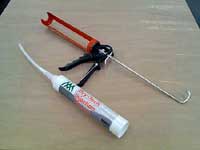
DPC injection cream cartridge with skeleton gun
Information and Main Features of DPC Injection Cream
- Quick and easy to install – drill the holes, blow out the dust, inject. No special tools required
- No wastage – Comes in a standard ‘mastic’ tube, ready to use and fits straight into your skeleton gun
- Low hazard – not even rated as irritant
- Spillage and mess eliminated – no liquids to spill or stain
- No electric DPC pump required – No electric pumps to hire or messy, smelly fluids just simple hand pressure only
- DIY technology – advanced emulsion uses active Silicone ingredient economically (Siloxane and Silane, for the technically minded) without running back out of the holes
Typical Usage Rates for Most DPC Injection Creams
The following information states typical usage rates for most DPC creams, however for accurate usage rates refer to the manufacturers guidelines for your particular product.
- 4.5 inch thick (115mm) single leaf wall – 1000cc (1 litre) per 9 metres, inject from either side
- 9 inch thick wall (230mm) double leaf solid or cavity – 1000cc(1 litre) per 4.5 metres, inject from one side or from both sides.
- 18 inch thick wall (460mm) solid or random fill – 1000cc (1 litre) per 2 metres, inject from both sides
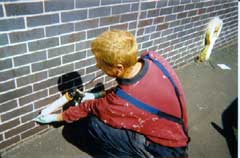
DPC cream injection being injected as a damp proof course to a property – Image courtesy of Property Repair Systems
How to Install a Damp Proof Course
First, check for high ground levels, leaking gutters and down pipes and any other water leaks. These should be fixed prior to any DPC injection taking place.
- Drill 12mm diameter holes at 115mm intervals in the mortar course (or via the brickwork, angled down to meet the mortar course) selected to be at least 150mm above outside or abutting ground level
- Fit the extension nozzle to the cartridge tube and load into the skeleton gun
- Inject cream from the bottom of the hole outwards until the hole is full.
- Holes can be capped with mortar or fitted with a plastic plug

Plastic tapered plugs for filling drill holes after injecting DPC cream
Walls and Skirting Board
Don’t forget to check the walls and skirting boards for dampness. Typically the best way to check for damp is to use a “damp meter”. These handy tools measure the moisture content in a given object or surface.
If any damp is found it will need to be dried after you have resolved any damp proof course issues and laid a new cream DPC. Once dried any damaged skirting, architrave or other timber will need to be replaced.
In the case of any damp plster, replaster to a minimum of 1.2 metres internally. It’s a good idea to also include additives such as salt neutralisers in with the plaster mix as this will prevent ‘salts’ damage to plaster finishes and decorations.
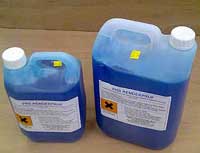
Replastering concentrated additive for renders to prevent salt growth – Image courtesy of Property Repair Systems
Replastering is an essential job after inserting a chemical damp proof course. For more information on how to do this correctly see our replastering project for detailed information.
In some cases you are better off using an Air Gap Membrane instead of sand and cement – Information and advice on these membranes and how to use them can be found here.
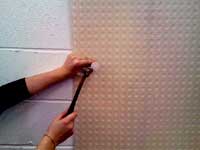
Air gap membrane can be used in place of plaster and is simply fixed with plastic plugs
What Depth Should Chemical Damp Proof be Injected?
The depth that the chemical damp proof should be injected is dependent on the thickness of the wall. Use these suggested injection depths as a guide and drill the holes to the following depths:
- For 115 mm walls (half brick thick) the holes should be 100mm deep
- 230mm walls (1 brick thick) the holes should be 210mm deep
- 345mm wall should have 320mm deep holes
- 460mm walls should have 430mm deep holes
The DPC cream that you use will have detailed instructions which you should follow. These should include information about the depth to which the chemical damp proof should be injected, but if not the above guidelines will suffice.
What is Needed to Inject a Damp Proof Course
Products and Tools Required
- DPC injection cream – There are quite a few available on the market today, a simple online search will reveal a selection. Some of the best are generally Permaguard, Dryzone and teh similar
- Skeleton Gun – either a 400cc or professional 1000cc
- 12mm masonry bit
- electric hammer drill
- eye protection
Injecting a damp proof course can seem like a daunting job if you have never tackled such a task before but many products come with detailed instruction and many manufacturers also include warranties and guarantees with their products.
Alternatively if you would like to know a little bit more about what’s involved with the whole process, see our damp proof injection and how it works project here.

